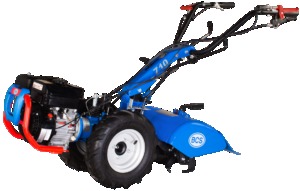

History of the Earth Tools logo
For many years, folks asked me: “Don’t you have a company logo?” And we really didn’t, as I just never took the time to come up with one…we just had “Earth Tools” written out in a blocky font, and that passed for a logo.
Finally, though, I decided to put some effort into it, and I hired my sister-in-law Trina Peiffer (my wife’s twin sister) to make a line drawing of the Earth Tools sign we have here at the shop. This sign is made out of a 4-foot length of Eastern Red Cedar log; the letters are carved with a chain saw.
I made this sign about 15 years ago (below is a photo). I figured this was a logo with some “meaning”…not just some arbitrary design. Hope you like it!
--Joel, Earth Tools owner

HAVING TROUBLE GETTING THROUGH ON OUR MAIN NUMBER ABOVE?
TRY 502-484-5550 or 0704
PEAK-SEASON ORDERING
PLEASE NOTE that we get VERY busy in the late Winter & Spring, and assembling/shipping wait times increase, just because of the "log-jam" of Tractor / Implement orders coming in all at once at "the last minute". So -- DON'T wait until the "last minute" to order! If you want equipment for this upcoming growing season, ORDER EARLY! Keep in mind that we ship orders on a "first-paid, first-shipped" basis...we do NOT offer "expidited" assembling/shipping of tractor & implement orders for an extra charge. We appreciate your business and your patience, and we work as hard as we can to get orders out as fast as possible, WITHOUT cutting corners on the proper equipment setup, prep & checkout that we are famous for.
-
>
- HOME
- FREQUENTLY ASKED QUESTIONS
- SPECIALS
- FINANCING
- NEW PRODUCTS
- WALK-BEHIND TRACTORS
- IMPLEMENTS for WALK-BEHIND TRACTORS
- ACCESSORIES for Tractors and Implements
- GRAIN HARVEST / THRESHING
- FRUIT / NUT HARVEST
- USED EQUIPMENT
- PROFESSIONAL MID-TINE TILLER
- PRODUCT AND SERVICE VIDEOS
- WARRANTY INFO
- GARDEN TOOLS
- MAINTENANCE AND REPAIR
- SPARE PARTS
- ACME ENGINE PARTS
- ORDERING AND CONTACT INFO
- COMPETITORS
- ABOUT US
- OTHER RESOURCES
- EMPLOYMENT OPPORTUNITIES
- ARTICLES
YOUR SOURCE FOR
bcs tillers, bcs sickle bars,
bcs lawn mowers, bcs snowblowers,
bcs brush mowers, bcs sweepers,
bcs chipper / shredder bcs attachments & bcs accessories
AND
rotary plows, mini hay balers,
hay rakes, spaders, cultivators,
flail mowers, seeder,
potato digger plow, utility trailers
& more!


Why are new BCS tractors BLACK or SILVER?
Beginning in late 2017, the BCS factory started a new “paint scheme” for their tractors and implements: The tractors are just painted BLACK, and the BCS-branded implements are painted SILVER. (and in 2023, the tractor bodies started coming through UNPAINTED...just bare aluminum) So, on the tractors, the only "blue" parts are now the plastic “beauty” shrouds for the handlebars.
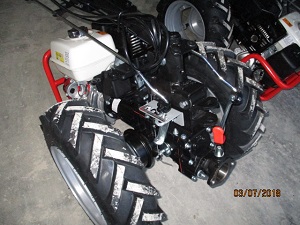
WHY?
Because the BCS factory in Italy produces 3 brands of walk-behind tractors on the same assembly line: BCS, Ferrari, and Pasquali (BCS purchased these other 2 companies in the 1990s…and no, this is NOT the automotive “Ferrari!”). Historically, they had different paint-lines for each tractor and implement line (Blue for BCS, Green for Ferrari, and Yellow for Pasquali)…but sometime in 2017, they decided to optimize efficiency by painting all the tractors and implements “neutral” colors and just letting the plastic shrouds and decals delineate what brand tractor it would be. Hence, "non-blue" BCS tractors started appearing in the USA in early 2018. (We have told BCS that we think this is a bad idea...the "blue" was a color most people associated with BCS, and now, if the plastic "beauty shrouds are discarded or lost, there is no color for "brand recognition", and that would hurt them more in the long run than the few bucks a tractor they're saving by not having separate paint lines in their factory. We'll see if they ever bring the "Blue" back...)
Wheel Options
Our walk-behind tractors can be equipped with various options regarding the wheels. The most popular are WHEEL WEIGHTS, OVERSIZE WHEELS, and FOAM-FILLING of the wheels. Here is a brief overview of pros & cons for these options:
WHEEL WEIGHTS: Any implement that requires lots of wheel traction to "do the work" (such as dozer blades, pull-type plows, cultivators, subsoilers, crimper-roller, etc.) will always work better if the tractor simply weighs more...because a heavier tractor can generate more traction. Adding this weight at the wheels is best, because adding weight at the wheels does not change the BALANCE of the machine...the weights are attached at the "fulcrum" of the tractor, which is the axle. Our "Barbell Weight Hangers" are the most popular option for this by far, because they utilize standard 1-inch center-hole barbell-weight plates for the actual weight...and you can find these just about anywhere, and used weights are just as heavy as new ones! (See this item on our Accessories page, Wheels section.)
PROS: The Barbell hanger option is inexpensive, and barbell weights go on & off the hangers easily & quickly. When the implement you are using demands extra tractor traction, put the weights on; when you want a lighter-weight, more maneuverable tractor (for example, for mowing), take the weights off. The posts can stay on the tractor even when no weights are in place.
CONS: If the "long" hangers are chosen, they do stick out a couple inches past the edges of the wheels.
OVERSIZE WHEELS: On most tractor models, you can move up to the next size larger wheel by just paying the cost difference between the two sizes (wheel prices shown on our Tractor Accessories page , Wheels section.
PROS: Increased clearance under tractor, less chance of "bottoming out" on rough/uneven terrain. Also increases ground speed slightly (for example: moving from 5x10x20" wheels to 5x12x22" wheels increases ground speed by about 10%).
CONS: Changes angle of tractor/implement, which can be a disadvantage with some implements...sickle bars & snowblowers particularly. A PTO extension can be used to help "flatten out" the implement angle in some cases. Also, the increase in ground speed can cause severe engine loading when using implements that can "max out" engine power in some conditions (flail mowers, snowblowers)...if the machine is moving 10% faster as a result of larger wheels, the engine is being forced to work 10% harder.
FOAM-FILLED WHEELS
This option means that the air in the tires has been replaced by a permanent solid rubber (pumped into the wheels as foam, but it solidifies into a pretty solid rubber).
PROS: Never a chance of a flat tire--ever. Zero tire maintenance. Also, you gain some traction through the extra weight of the solid rubber (extra weight per tire-size shown on our Accessories page, Wheels section)
CONS: You cannot remove this extra weight--ever. Tractor weight will be increased 25% - 40% permanently. If you are aiming for minimum-compaction in soil beds, this could be problematic. Also, the extra weight increases the stopping distance...the extra inertia makes it more difficult to stop the tractor (most noticeable when mowing, and especially going downhill). It could be added that a foam-filled wheel is also impossible to remove from the rim without cutting the tire in half, but since the tires will not wear out on a low-speed machine like this in 30+ years anyway, this is not really a concern. Lastly, The company we use to foam-fill the tires does not always do a “pristine” job in terms of appearance…that is, the tires / rims sometimes get spattered or dripped on with the foam-fill material (dark brown stuff). If the looks of this residue bother you, it does peel off with a bit of effort…
Differential vs. Solid Axle: What’s the difference?
A Differential is a gearing device in the center of an axle that essentially splits the rotational power between the two wheels that are on either end of that axle. Therefore, a differential allows the two wheels on the same axle to rotate at different speeds, or even one wheel to rotate while the other is motionless. All cars, trucks, large tractors, etc. have Differentials on their drive axles. (If they did NOT, every time you went around a corner in your car, one of the wheels would leave a black mark on the pavement…since during a turn, the OUTER wheels rotate faster than the INNER wheels, because the outer wheels are covering more ground.) Having a Differential on a Walk-behind tractor, therefore, allows the operator to maneuver the machine with little effort, since during a turn (for example, at the end of a garden row), the two wheels can rotate at different speeds, and therefore you do not have to “drag” a wheel during a turn. If a Differential-equipped Walk-behind tractor is also equipped with Steering Brakes (such as several of the larger machines are) , this adds the “next step” in ease of maneuvering, since the operator can simply apply one of the brakes, which slows down one of the wheels and therefore speeds up the other, and the tractor more or less turns itself.
Now, with a Differential, there are times when ONE of the wheels on the axle will lose traction, and it will just sit there and spin, while the other wheel does nothing. (Ever seen a 2-wheel drive vehicle stuck in the snow or mud? Typically only ONE wheel will be spinning) This is because the Differential does not know the difference between when the vehicle is going around a corner, or if it is trying to get out of a mudhole…if one wheel will rotate easier than the other, the Differential will simply put all the power to that wheel. This is why all of our walk-behind tractors with Differential are also equipped with a “Differential Lock”, which over-rides the Differential and locks the 2 wheels together. Once the Differential is “Locked”, you have equal traction with both wheels…but the tractor also gets much harder to maneuver, since the wheels can no longer rotate independently of each other! The Differential Lock/Unlock control is located right on the tractor handlebars, and can be activated anytime, even with the tractor in motion.
The smaller Walk-behind tractors typically do NOT have a Differential on the axle. (If there is no Differential, it is considered a “Solid Axle” because the axle is a solid piece that connects the two wheels all the time.) With this system, one of the wheels has to “break traction” during a turn, and essentially be “dragged” around. The smaller tractors are constructed this way for two reasons: 1. The differential is a very expensive-to-produce device, and not installing it keeps the cost down on the smaller tractor models; and 2. The smaller tractors are lighter in weight, and can be maneuvered with relative ease even without a differential. (the smaller machines come standard with a narrower wheel track as well, to aid in maneuvering…it is much easier to “break traction” on the wheels during a turn when the wheels are closer together)
What is the BCS PowerSafe clutch, and is it a good thing?
PowerSafe™ is BCS’s brand name for a new “hydro-mechanical” clutch system introduced by BCS in Europe in 2011, and in North America in 2012. It appears in North America on the BCS models 660, 739, 749, 750, 770, 780, 779, and 889. It is a clutch that uses hydraulic pressure to press the clutch plates together (rather than spring-tension, like in any “standard” clutch) to transfer power. Therefore, tractors with the PowerSafe clutch have a built-in hydraulic micro-pump, which circulates oil through an oil filter and to the clutch. This type of clutch is also in an oil bath, so it is cooled by the circulating oil (rather than just by air) and is therefore supposedly harder to overheat.
This type of system has never been used before in a walk-behind tractor, and frankly, we at Earth Tools do not know what the durability will be over time. As I can see it now (Joel, Earth Tools owner, writing 8/1/2025), here are lists of the advantages/disadvantages:
Advantages:
- Relative ease of using the clutch control, because the control is only moving a valve…not compressing a large clutch spring.
- Very safe…the “operator presence” safety handle on the handlebars (the one you have to hold down to make the machine go) is hooked into the clutching system as well, so if you let go of the machine, it is just like you squeezed the clutch handle…the machine stops instantly, but the engine does NOT quit. (There is a separate control for turning off the engine)
- Probably easier for someone to use who has no experience with a clutch at all (i.e. someone who has never driven a stick-shift), because of the fact that this wet-clutch system makes it harder to “abuse” the clutch through overheating.
- BCS offers an extended warranty of 5 years total on this clutching system (3 years on standard clutch). (Interestingly, BCS only started offering this “extended” warranty after sales were bad on the PowerSafe models for the first 2 years…they needed an extra “hook”.)
- The PowerSafe system has a "drivetrain brake" built into it that instantly stops the transmission when the clutch lever is squeezed (or the safety lever is released) while the tractor gearshift selector is still "in gear" (the drivetrain brake does no good if you put the gearshift selector in neutral!) This is a handy feature when using the machine on slopes...but it has a disadvantage (see below).
- The PowerSafe models also come with a "parking brake" that locks both wheels by pulling a single lever on the handlebars. Again, this is handy if you are working on steep slopes. (Other BCS models that have "steering brakes" can also have the braked "locked" for parking, but the locks are engaged independedntly on each of the two brake controls) This feature has a down-side, though...see below.
Disdvantages:
- Requires more frequent transmission oil changes, with oil filter changes: Every 100 working hours (30 hours for the initial break-in oil)…an extra expense. (and if you do not perform this as per BCS’s schedule, the warranty on the clutch is VOID)
- Tractors with this clutching system are NOT equipped with the higher “transport” gear that the “standard clutch” tractors have. If you plan on using a utility trailer with your walk-behind tractor, the lack of the faster “transport” speed can be a bummer.
- The MUCH higher complexity of the PowerSafe hydraulic clutch system means that if anything goes wrong with the clutch “internals” over time, you pretty much HAVE to bring it to a dealer for service, as there are special techniques / tools required. By comparison, the standard clutch systems are simple enough that many of our customers (farmers, homeowners) have serviced their own for years…if fact, we have complete standard-type clutch removal & installation instructions on our website (I would not even attempt posting instructions like this for the PowerSafe…way too complicated!!), and we offer a 1-or-2-day-turnaround time for rebuilding standard clutches, if the need arises. So the PowerSafe clutch is not a good choice for Do-It-Yourself folks who want to be able to rely on their own skills/common tools in maintaining their equipment.
- The oil filter is a bit exposed, right under/behind the engine. At present, we have had 3 of our customers accidentally break the filter off while brush mowing in rough terrain. The repairs were not expensive (about $50), but of course their tractor was stuck in the field until they got a new part…since with the filter broken off, the hydraulic system just pumps the oil out onto the ground. (We have recommended to BCS that they install a skid-plate at the factory under the filter…no changes yet, though.)
- Because of the "drivetrain brake" feature mentioned in the "advantages" section above, the transmission STOPS IMMEDIATELY when the clutch is activated. This means that SHIFTING GEARS is actually a little harder on the PowerSafe models, because if the transmission gears have "stopped" in a place where they are not quite lined up, you can't "feather" the clutch to get the gears to engage (if you try "feathering" a PowerSafe clutch, you WILL grind the gears Once the "drivetrain brake' disengages, it instantly goes to FULL POWER). This is particularly noticeable (and irritating) with the PTO engagement lever. (in fact, it was a big enough issue that we shot a video specific to engaging the PTO on our various walk-behind tractor models: https://www.youtube.com/watch?v=RKhtwCGDops )
- Because of the "single-lever parking brake" mentioned in the "advantages" section above, the support bracket for the brake activation cables has been changed by BCS to accomodate the extra cables for the parking brake. On PowerSafe models with "independent steering brakes" (749, 750, 779), this means that the steering-brake cables are also routed through this new bracket. WELL, the BCS engineers didn't think this one through too well...the new position for the cables makes them LESS EFFECTIVE for activating the steering brakes, due to a bad angle of attachment. Compared to the "dry clutch" tractors with steering brakes (852, 853), the steering brakes on the PowerSafe models are about 30% less effective. We have showed BCS how this could be fixed (by making a different support bracket that improves the cable attachment angle), but in 10 years, they have made no changes.
One further note: the “safety” system on the tractors with standard clutches is what you have been used to for the last 30 years, if you operated any power equipment at all: When you let go of the “safety” handle on the handlebars, the engine quits. This passes all North American safety standards for walk-behind power equipment. AND: If the operator needs to walk away from the machine while it is running, there is a provision to do so: Simply squeeze the clutch handle, and engage a small latch, which keeps the clutch handle in the “squeezed” position…this automatically keeps the “safety” lever down and allows the engine to run….but with the clutch handle squeezed, no power can go to the wheels or implement. If the clutch is released, the safety lever pops up instantly, and kills the engine. (I mention this because BCS America’s website implies that the PowerSafe-equipped tractors are the only models where you can walk away from the handlebars and the engine will not quit. This is a complete fallacy!! BCS is just trying hard to market the technology that they recently invested so many millions of Dollars/Euros in.)
The bottom line is this: As stated above, we don’t know how the PowerSafe clutches will hold up in the long run. They may be great, they may be a bomb…but without many years of service history to look at, we just don’t know. What we DO know is that the standard clutches have been around for over 50 years, and when used properly, they can easily last up to 2000 hours of service….and that they can be replaced pretty easily by anyone who has basic mechanical skill.
So, take your pick…we stock all models (and we stock plenty of PowerSafe oil filters, too!)
WHY two 800 series models -- 852 and 853? What’s the difference?
These two models are “sister machines”—virtually identical except for ONE difference: The direction that the TRANSPORT speed functions in. The “working” speeds on all BCS tractors work in both directions, through a geared “shuttle shift” lever…but the because of the space-efficient way these transmissions are constructed, the “transport” speed (4th gear, in the case of the 800 series tractors) only goes in ONE direction, based on which direction the worm drive gear for the axle is cut. The result: The 852 has the 4th gear “transport” speed working in FORWARD ONLY when the tractor is in the FRONT-PTO (mowing) MODE, while the 853 has the 4th gear “transport” gear working in FORWARD ONLY when the tractor is in the REAR-PTO (Tilling) MODE (this is the direction that the tractor would pull a utility trailer, compost spreader, or anything hooked to the "tow hitch" of the tractor, which makes the 853 typically a better seller).
Because of the implement selection some customers choose, the transport speed operating in one OR the other direction (Front-PTO OR Rear-PTO direction) is sometimes more desirable…so we stock both the 852s and 853s, to better serve our customers.
For example: if an individual is going to be running primarily mowing, haymaking, or snow removal equipment (all Front-PTO), and will maybe run a tiller some, then the tractor that has the transport speed working in Front-PTO mode is desirable: this is the 852. However, if the tractor is going to be used for a mixture of applications (mowing, soil-working, etc.) and especially if a rear-mounted utility cart is one of the implements in your future: then the 853 makes more sense.
PLEASE NOTE: The working speeds (1st, 2nd and 3rd gears) on the 852 & 853 are IDENTICAL, so actual mowing, tilling, etc. speeds on both tractors are the same. The issue here is which direction you want the fast “point-A-to-point-B” 4th “transport” gear operational.
Implement applicability and all other features are the same on the 852 and 853.
BCS Model 710 walk-behind tractor
(Shown with 18” tiller implement)
The 710 uses the same 2-working-speed transmission with transport speed as the 718 / 722, but has the lighter-duty handlebars of an earlier BCS machine (model 716), which were not quite as adjustable and cheaper to produce (hence, part of the reason for the lower price). This tractor is equipped with a commercial-grade Kohler 7hp engine, and is a great minimum-priced BCS tractor for small properties and gardens, with no sacrifice of the power-train quality of the larger models.
NOTE: When figuring out implement compatibility on our chart: This tractor will run the same implement selection as the BCS 718.
Tractor/Implement Compatibility Chart
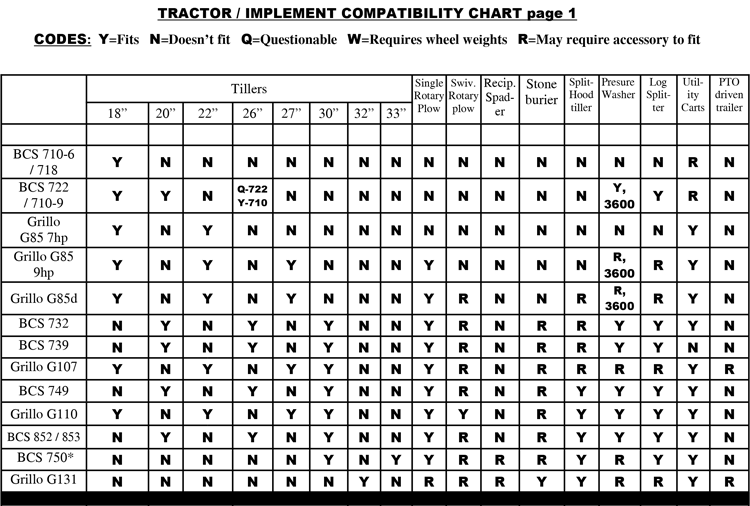

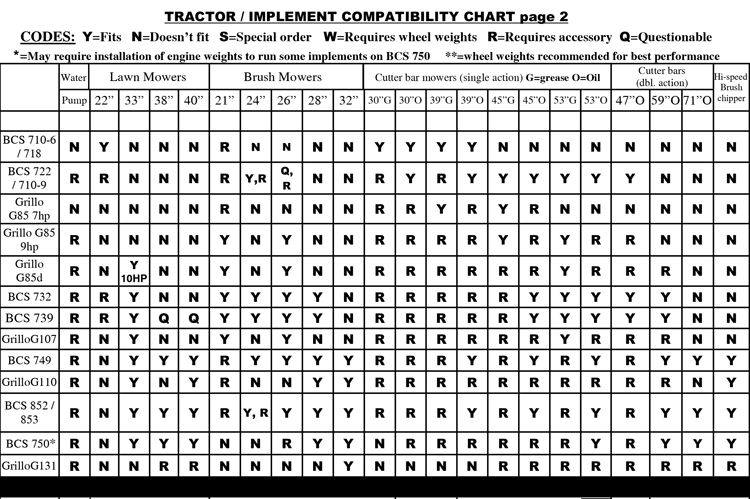
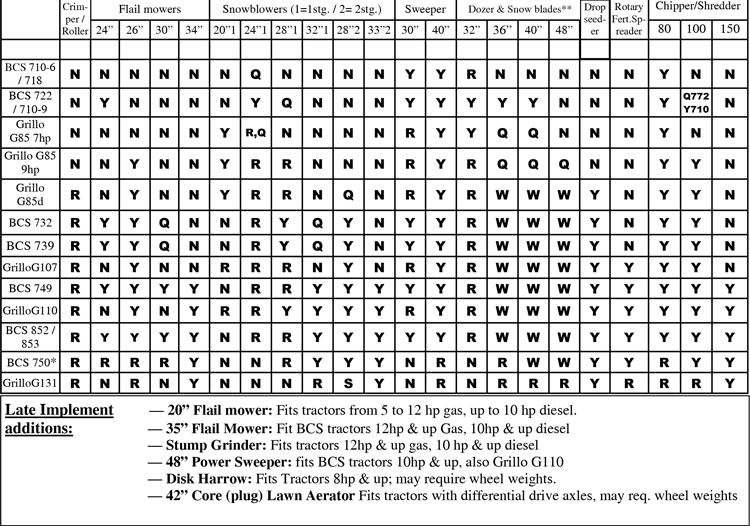
Comparable Grillo tractor: G85 6.6hp
Prices (tractor only…does not include any implement) :
- 7hp Kohler gas: MSRP:
$2350 Earth Tools Regular Sale price: $2232YEAR-END PROMO PRICE UNTIL DEC 31 2025: $2173.75
Specifications
| Engine Type/HP | Kohler CH270 |
| Starting System | Recoil |
| Clutch | Conical, automotive type |
| Transmission | All hardened steel gears and shafts supported by ball bearings, in oil bath |
| Differential (details here) |
None (solid axle) |
| Steering Brakes | None |
| Tilling speeds (rear PTO) |
Fwd: 0.65, 1.3, 6.5 mph • Rev: 0.7, 1.4 mph |
| Mowing speeds (front PTO) |
Fwd: 0.75, 1.7 mph • Rev: 0.7, 1.6 mph |
| Wheel Size | 4”x8”x16”fixed rim, tractor tread, tube type |
| Outside wheel track (w/o accessories) | 16 inches |
| Safety Features | Operator presence control (deadman switch), Reverse Gear/PTO Lockout (to prevent tilling in reverse) |
| Handlebars | Anti-vibrated, instantly adjustable up and down and side-to-side; also fully reversible to convert from front PTO to rear PTO mode. All controls on handles. |
| PTO Type | Independent, 990 RPM at max engine speed |
| Method of changing implements |
Two 12mm threaded studs with nuts or optional Quick Hitch |
| Tractor Weight (w/o implements) |
135 lbs |
EARTH TOOLS, Inc.
1525 Kays Branch Road
Owenton, KY 40359
(502) 484-3988 tel.
(502) 237-1026 fax.
NOTE REGARDING
HOLIDAY CLOSINGS:
Annual Winter vacation: in 2025, closed from Wednesday Dec 24th until the first Business Day of New Year (in 2026, re-opening Friday Jan 2nd).
Also closed Martin Luther King day (Jan 20th), Memorial Day (May 26th), June 27th (Multiculturalism Day, National Ice Cream Cake Day, National Onion Day--mixing the last 2 is not recommended), USA Independence Day (July 4th), Labor Day (Sept 1st) and the Thursday and Friday of Thanksgiving (Nov 27 & 28).
9:00 AM - 6:00 PM EST
9:00 AM - 5:00 PM EST
If you’d like to visit our shop, we have plenty of land to demonstrate our walk-behind tractors with any implement. But if you’re coming to visit, CALL AHEAD at least one day in advance! Retail business hours are by appointment (yes, weekends, too), so the more notice you give us the better we can set our schedule to fit your schedule. We are occasionally out of the shop doing deliveries, demonstrations or displaying equipment at trade shows.
© Copyright 2003-2025 - Earth Tools, Inc. All rights reserved.
Reproduction in whole or part without permission is prohibited.





